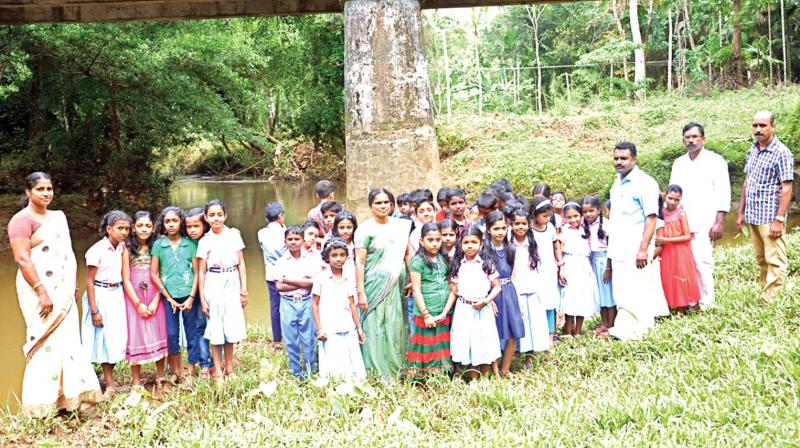We saved river near school

Kollam: Environmental organisations, NGOs and even political parties consider it revolutionary when a river is revived from its imminent death in the times of global warming and climate change. Such a revolution is pioneered by the students of a village primary school where they bring a river, abandoned by the people over time, back to life. Pallikkalaar, the river originating at Chooralvayal in Palamel panchayat in Alappuzha, flows around 42 kilometers to reach the Vattakkayal in Karunagappally. Of the 44 rivers in the State, Pallikkalaar is the only river that is fed by over 60 rivulets unlike the ones which originate in a hill. The river, which bears memories of Sooranad revolt which marked the Communist rising over the feudal stranglehold in Kollam and serves as the lifeline of nearly 25 villages in Pathanamthitta and Kollam districts, had stagnated owing to encroachment, pollution and garbage piles over the last decade. The river has now got new lease life with efforts and enthusiasm of students of the Thengamom LP School in Pathanamthitta district.
It all started when the students of standard IV of the school visited river as part of their extra-curricular activities in April this year. “The rivulets of Pallikkalar flow close to our school,” P. Athul, a student who was in the forefront of the team, told DC. “During our study we found abandoned bottles and garbage piled in sacks preventing the flow of the river. We wanted to save it.” The river went into stagnation for two reasons: encroachment which narrowed its path and disposal of waste which stopped its flow. “Several places including the 12-kilometer stretch from Nellimukal to Moozhi in Adoor are under the grip of encroachers,” said Shyni Jose, Adoor municipality chairperson. Several spots that were 20 meters wide are hardly three meters now, thanks to encroachments. The river had virtually become the drainage canal for townships like Adoor.
The level of coliform bacteria in the water even posed threat to drinking water distribution from the river. The ever-spreading water weed cabomba aquatic ensured that the river had no chance to come back to life. The rivulets that recharged the river were also blocked with human intervention. The students who returned from seeing the stagnated river prepared a detailed report on its preset state with the help of their teachers. “They wanted the river saved,” PTA president Jayan B. Thengamam told DC. The PTA backed the idea and helped the formation of an action council to coordinate the rejuvenation works with the help of state government agencies. The students then met Chief Minister Pinarayi Vijayan with a detailed report they had prepared. Finance Minister Dr Thomas Isaac, who came to know about the project, visited the river and offered help. He in fact declared a package for the rescue of the river on International Labour Day on May 1. The Kerala State Planning Board also chipped in, giving directions to various departments to sanction sufficient funds for the rejuvenation process.
The action council then went ahead with the formation of peoples' committees at ward level. The committees included Kudumbashree members, people’s representatives and MGNREGA workers. Awareness campaigns were taken up among the people residing on the banks of the river on the need of its conservation. The first phase of the project was to prepare documents after conducting surveys on either sides of the river. Once that done, then the Kerala State Suchitwa Mission came forward with a plan to address the garbage disposal issues while the cleaning up of the river was taken up by the MGNREGA workers after it was listed as a project they could work on. The sides of the river were then protected with coir geo-textiles which stopped soil erosion. The next move was to plant ethnic varieties such as vetiver, bamboo and screwpine. By the time it has almost become a mass movement. The three-months effort, which were meticulopulsy planned and executed, has resulted the free flow of the river now. The river is gaining its might, making the dream of the children who visted it once come true.
The river that fed reds
Pallikkalaar has a history of its own, and is part of the history of Oanattukara, the region in central Travancore. The river is also known for its association with the revolt of Sooranadu of 1949, led by the early communist movement in the state. The early Communist leaders who had fought against the feudal order used to seek refuge in the banks of the river which had plenty of betel leaves and banana plantations. The fields near to Pallikkal check dam was a meeting place of the young comrades who were ousted from their homes by the order of Thennala landlords.
The action council for the revolt of 1949 December 31 was also formed in the banks of Pallikkal. The river played a role in the economic and social development of the people. A number of industries including coir in Kannetti areas, mat production using pandanus leaves, mining of white clay for Travancore Cements and the famous baked bricks of Pavumba came up on its banks. The region is also known for its sugar cane cultivation, fed by the river. It also backed the agrarian culture of Onattukara at large.

